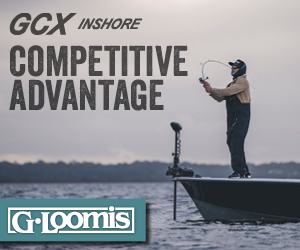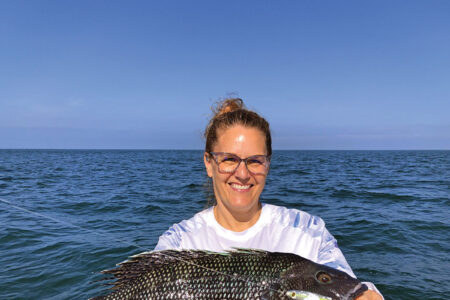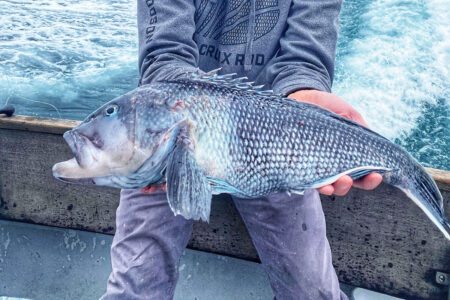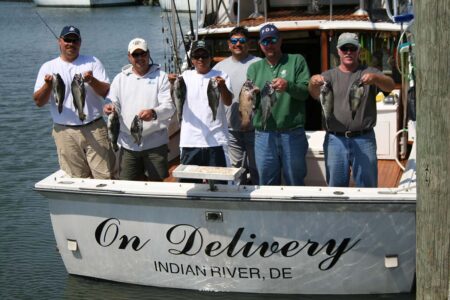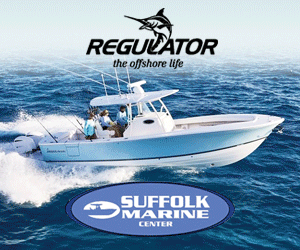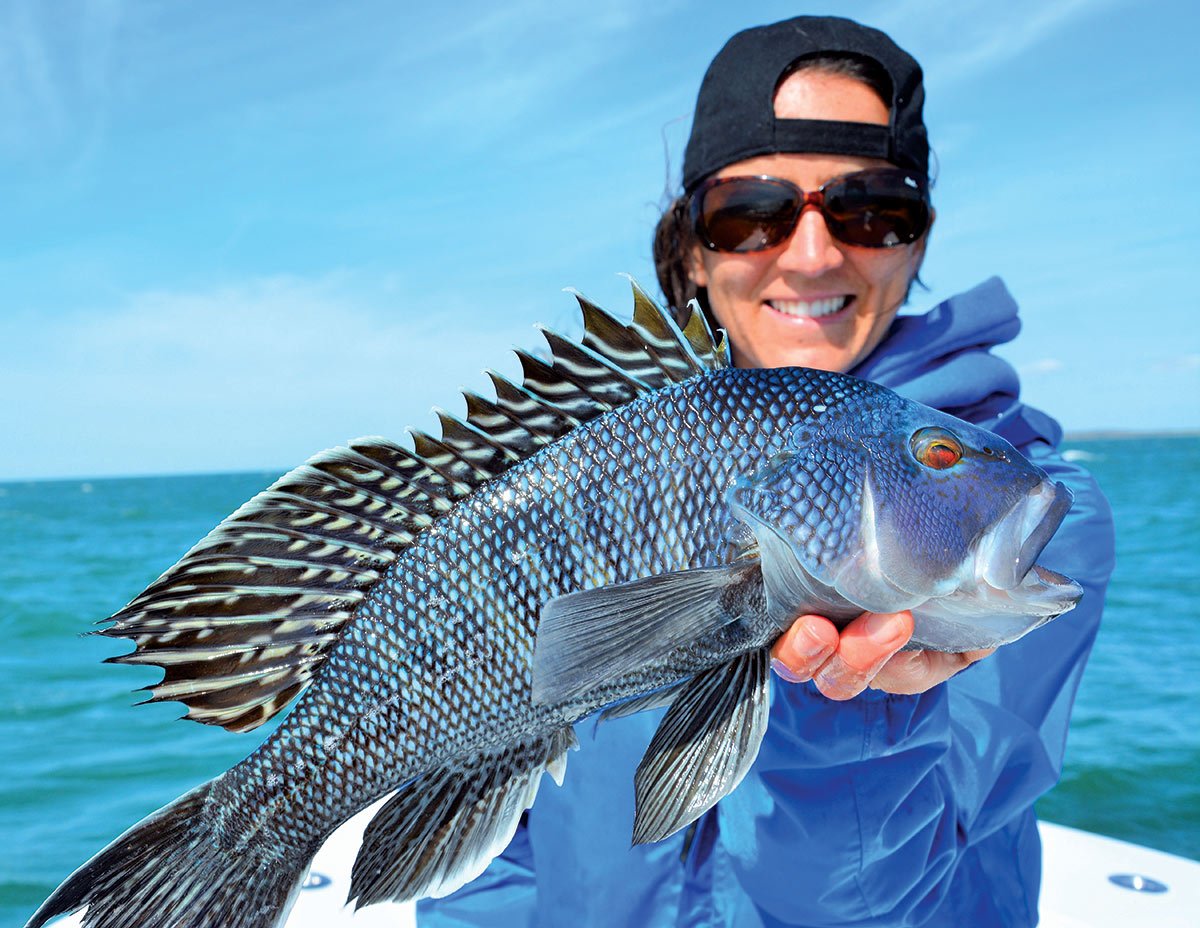
There is no reason to gear up with heavy gear to crank up doubleheaders for the freezer when you can still fill your limit and have a lot more fun doing it with light tackle.
It wasn’t too long ago that sea bass drew very little attention from most inshore anglers, especially those who preferred to target gamefish species that could be caught with regularity on artificial lures. Sea bass were primarily the domain of sinker bouncers and pinhookers, withtheir availability somewhat limited to certain wrecks, reefs and rockpiles. Some anglers, snobby as it might sound, even considered them second class citizens.
That attitude is a distant memory these days for a lot of reasons. Their overall abundance, and the number of large fish in the fishery have certainly drawn a lot of attention from anglers, but there is a lot more to this story. The large numbers of sea bass resulted in them expanding their range further northward into parts of New England where they had never, or rarely been caught before. Their numbers and expanded range has resulted in excellent fishing opportunities in near shore areas, as well as in deeper ocean waters, giving small boatmen excellent opportunities to target them in relatively calm, sheltered waters during various parts of the season.
There are times when the bottom appears paved with sea bass, so much so that some lobstermen claim they are doing irreparable damage to the lobster population as a result of their voracious appetite, – they are especially fond of baby lobsters. That gluttonous appetite is also part of the sea bass’ rise to fame. It makes them easy targets for not only traditional baits like squid and clams, but a host of artificial offerings as well.
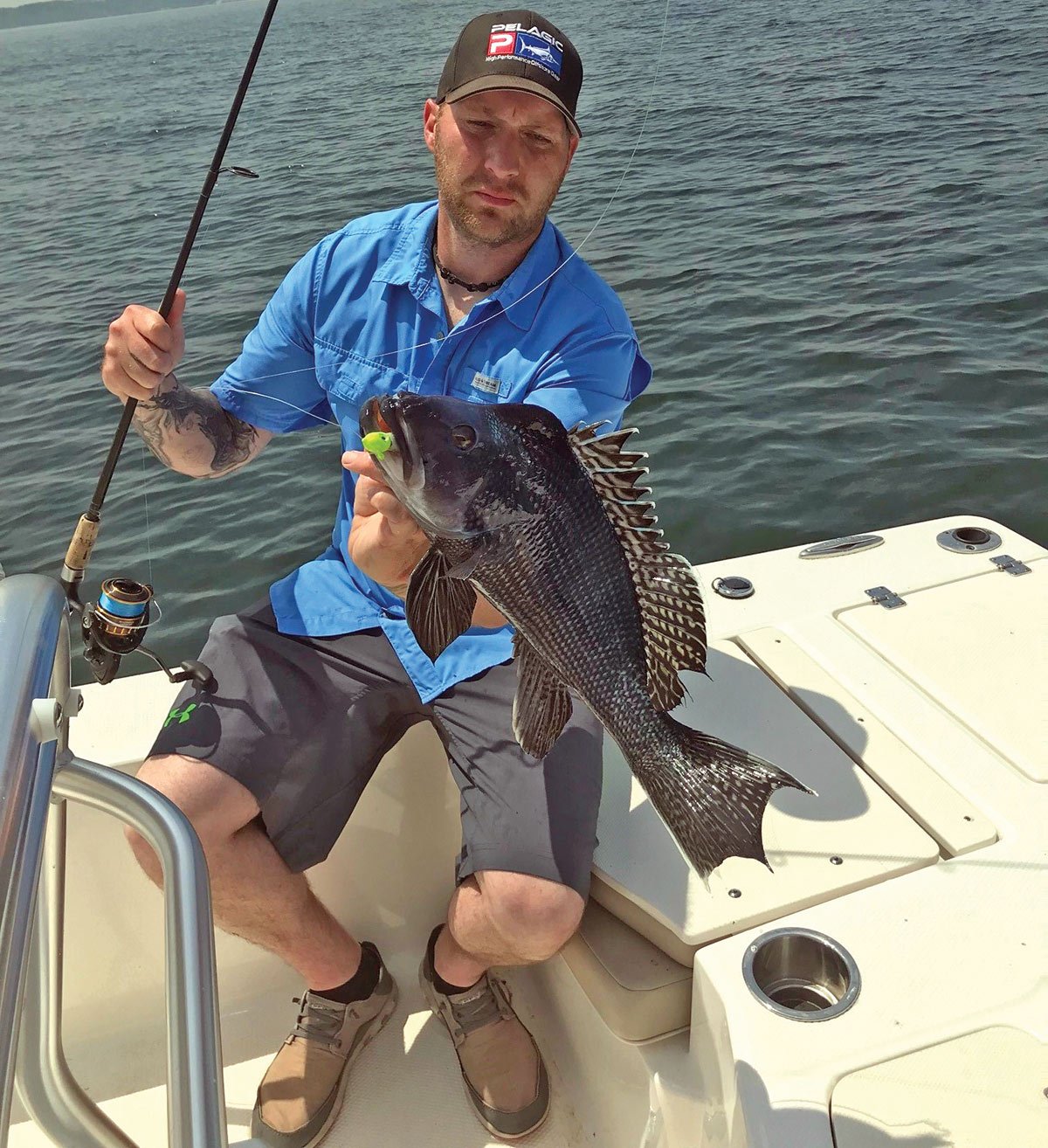
This penchant to attack artificials goes hand in hand with what I believe is the real reason for their zoom to the top of the popularity chart. The surge in light tackle fishing over the past decade, but especially in the last few years for species like fluke, weakfish, striped bass, bluefish and even porgies was made to order for the boom in the sea bass population. Their tenacious fighting ability, their penchant for artificial lures, and the ability to catch large numbers of fish in the 2 to 5-pound range in relatively shallow water make them the perfect fit for light tackle.The exception is late in the season when fishing for them is concentrated on offshore wrecks and the prudent choice becomes beefier tackle.
Light action spinning rods in the 6 to 7-foot range matched to 2500 and 3000 series reels spooled with 8 to 15-pound test braid have become the tackle of choice for many anglers these days. It allows you to fish smaller and lighter payloads, often the key to making most of these species bite, while larger offerings get ignored. The lighter, fine diameter lines allow you to get down to the bottom where the bulk of feeding activity is taking place, and the light tackle allows for a better presentation and much better feel than heavier gear. Part of that presentation is the ability to cast your offering and work it back to the boat when there is little or no drift, or at the other extreme, when the drift is too fast. More on this later. At the terminal end, I like a 4 to 6 foot length of 20-pound fluorocarbon connected to the braid with your choice of an Alberto, FG or Double-Uni knot. I always tie leadheads and bucktails direct to the fluorocarbon with an improved clinch, a knot that I have supreme confidence in.
Thanks to tremendous strides in fishing tackle technology, especially in rods and lines, there is little concern that your light tackle outfit will be overmatched by the biggest sea bass, or the biggest fluke, or striped bass for that matter. Encountering these other gamefish while targeting sea bass is a real possibility in many areas and adds to the appeal of this light tackle approach.
When it comes to putting together your sea bass arsenal, there are plenty of choices, but where light tackle is concerned, the two key components are bucktails and plain lead jig heads. Everyone seems to have their own preference for the type of head they prefer on these jigs. My personal preference for bucktails is the old standby Smilin’ Bill, the ball head and the narrower Spro-shaped head, which tends to have a faster sinker rate due to that narrower shape. When it comes to plain jig heads, a ballhead with a pair of large eyes is my first choice.
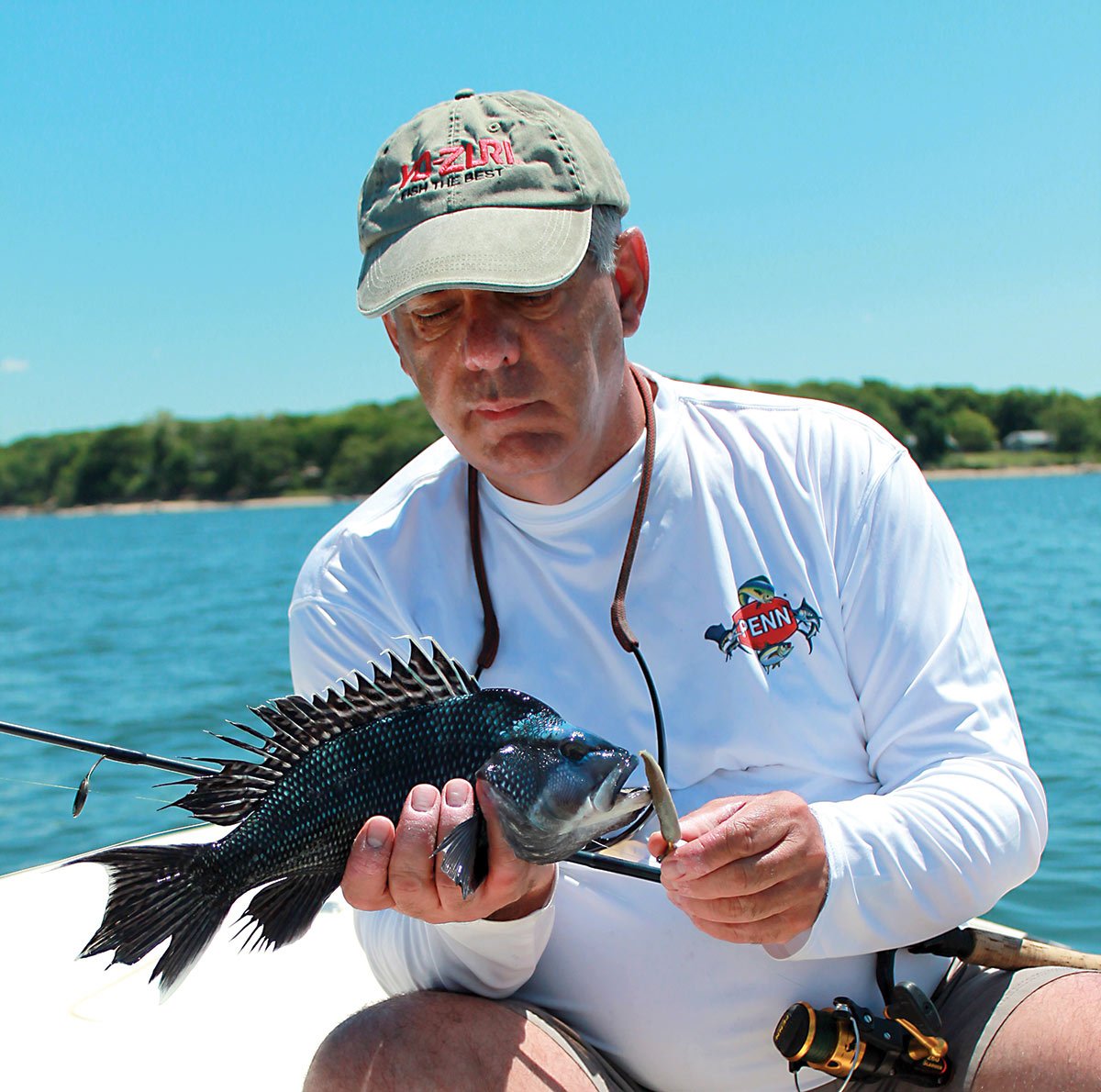
A naked bucktail will draw strikes from sea bass but is no match for a bucktail or leadhead dressed with one of the many different types of soft plastics, and especially Gulp. Sea bass love Gulp and I’ve done very well with the Gulp Sand Eel, Swimming Mullet, Shrimp, Grub and Minnow. Dressing your hook with a strip of squid will work, as will strips of Fat Cow or Otter Tails. Soft plastics like Bass Assassins, Keitech Swimbaits,Fin-S Fish, Jelly Worms and a host of others will all draw strikes from the normally aggressive sea bass.
Depending on water depth, current and drift speed, leadheads ranging from ½ to 1.5 ounces should cover most situations, with 2 ounces at the extreme end. I’ve yet to go to 2 ounces but depending on where you fish, you might consider a few as backup. I have fished in up to 75 feet of water in a running tide with 1 and 1-1/2 leadheads with no problem. The key is angling your casts into the direction of your drift and allowing the lure to get down to the bottom before beginning your retrieve. Your retrieve should be just fast enough to keep the slack out of your line as the distance between your lure and the boat narrows. If you feel you are losing touch with the bottom as the jig nears the boat, open your bail and allow it to fall back to the bottom. Very often, the hit will come as the boat passes by your jig and it begins to rise from the bottom.
At the other end of the spectrum, and this goes for lots of other species, not just sea bass, one of the great advantages to fishing light spinning tackle is the ability to cast and retrieve your jig when there is little or no drift, such as slack tide, or a wind against tide situation. I can’t tell you how many times others have blamed the fish going off their feed on the dying current, when in fact, it is because their baits which had relied on the current for movement, were now sitting still on the bottom. Needless to say, you cover a lot more bottom when casting as opposed to simply letting your offering drag in the wake of a drifting boat, which also requires more weight due to the added drag on your line.
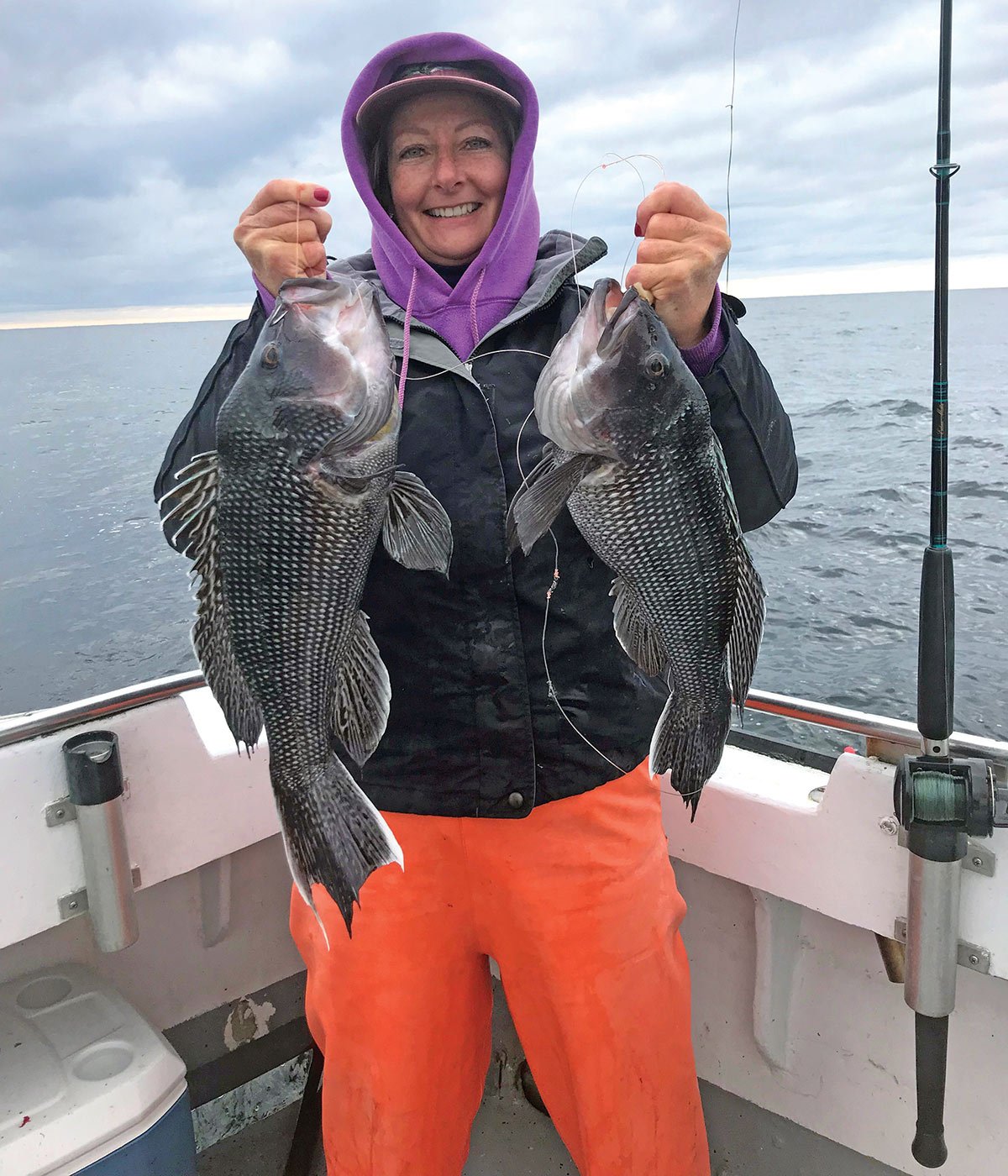
When it comes to working your jig, there are times when just a snap of the wrist will work as well as any retrieve, but over the long run, the snap jigging technique, a very exaggerated hard jigging motion, will outfish most other retrieves. The negative side to snap jigging is it becomes tiring and it can be difficult to keep up the pace during a lengthy stint on the water. For that reason, I suggest using a mix of both retrieves and lean toward the most productive as the day progresses. Regardless of how you work your jig, it is critical that you maintain contact with your lure throughout the retrieve, and also develop a feel for the bottom. If you are not making consistent but brief contact with the bottom, your catch rate will suffer.
As I alluded to earlier, another one of the virtues of this light tackle approach with artificials for sea bass is the ability to draw strikes from other species. We have had days when targeting sea bass that we also had striped bass, bluefish, weakfish, porgies and fluke take the same offerings. The bluefish we could do without since they make quick work of soft plastics and you can find yourself going through lots of jigheads. Nothing against bluefish – they are great fun and the small ones make great eating when fried up with a batch of caramelized onions, but there is a time and a place for tanging with Mr. Yellow Eyes. And while we’re on the subject of eating, that is another big plus in the sea bass’ popularity. They are excellent on the dinner table.
Black sea bass regulations are unnecessarily stringent in most state and in most people’s eyes given the fact that the stocks are at 240 percent (almost 2-1/2 times) of the target biomass. So the reality is that with relatively shorter seasons, in some cases in-season closures, and reduced bag limits, (Go to thefisherman.com for sea bass regulations in your state.) you will be releasing many of the sea bass you catch, rather than trying to stuff a cooler with them. Going the light tackle route will provide a lot more enjoyment with every one of the fish you keep, and the ones you release. For a large part of the season, there is no reason to gear up with heavy gear to crank up doubleheaders for the freezer when you can still fill your limit and have a lot more fun doing it with light tackle.
